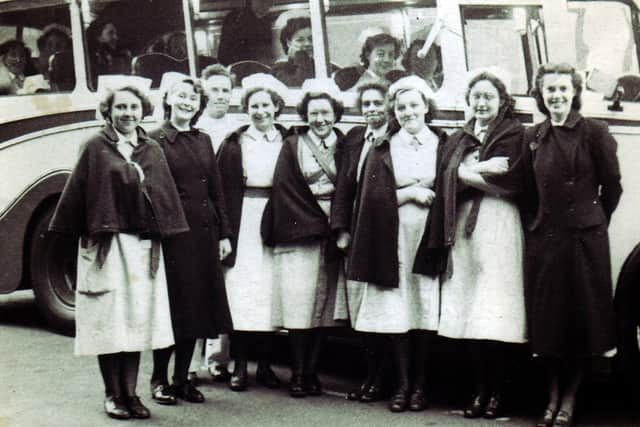Retro column: 1950s Sheffield healthcare memories of Lodge Moor isolation hospital, frightening dentist and home remedies
and live on Freeview channel 276
By and large, we were pretty fit children in the 1950s. We had survived the war years with the rationing that went with it and the lack of sweets and fizzy drinks didn’t seem to have done us much harm.
However, you couldn’t do much about the illnesses that were rife during that time. There was whooping cough, measles, chickenpox, German measles, TB and mumps and a widespread outbreak of polio in 1955, after which every child was immunized as a matter of course. It was not uncommon to see children wearing calipers after contracting the illness.
Advertisement
Hide AdAdvertisement
Hide AdWhen I was around seven years old, and with the National Health Service in its infancy having started in 1948, I contracted scarlet fever and was sent to Lodge Moor Hospital which had opened in Sheffield in 1888. The site has become an upmarket housing estate.


Parents were only allowed to visit their children on Saturdays and Sundays as rules were strict in isolation hospitals, and I remember looking out of a window and seeing my mother running up the long hospital drive from the bus stop. My father would have been at home looking after my sister.
I can’t remember being unduly upset. It seemed like a bit of a holiday and I helped the nurses make the beds. I never forgot how to do hospital corners with sheets!
Patients received a hospital number and, if admitted, the numbers would be printed in the Sheffield Star. You could have the severity of your condition checked against the categories, using your number.
Advertisement
Hide AdAdvertisement
Hide AdSheffield was well off for hospitals. There was the Jessop Hospital for Women, City General, later to become Northern General, Royal Infirmary and Royal Hospital.
Prior to the NHS, there was a scheme for working class contributions of 3d a week deductible from wages, to pay for healthcare.
Some years after, I had to have my tonsils out, in common with many other children who were susceptible to the frequent colds, flu, and chest ailments of the time. I went into the Royal Infirmary which was the site on Infirmary Road where Tesco supermarket is now situated. Luckily, part of the fine building behind has been retained as offices.
I remember dormitory wards, the smell of disinfectant and coal tar soap, lots of blood and children crying. For some time afterwards I could only eat ice cream, which was OK as far as I was concerned! There were stories of children being fed Cornflakes to harden up their throats which must have been agony.
Advertisement
Hide AdAdvertisement
Hide AdIn those days you could turn up at the doctors and wait to see him. There were no telephones easily accessible to ring the surgery.
Doctors made a lot of home visits then and if you were ill you stayed in bed and waited for him to come. There were very few female doctors then. My sister and I had an open fire in our bedroom which our mother lit when we were ill.
Although free healthcare had been introduced, it cost one shilling to get a prescription dispensed and also a charge of £1 for dental treatment. That treatment was horrendous and frightening in the 1950s.
It also seemed to be quite primitive involving much extraction of teeth using a dreadful black rubber face mask held over your nose and mouth to administer the anaesthetic gas to send you to sleep.
Advertisement
Hide AdAdvertisement
Hide AdIt also gave you the most terrible nightmares and hallucinations. You could taste the dried blood for days after. The sound of the high-pitched drill was enough to scare the living daylights out of you.
Parents were pretty knowledgeable when it came to home remedies. Or at least thought they were!
There were cures for all and everything then. A spoon or a bunch of keys down the back of your jumper would cure hiccups.
Vinegar on a cloth placed on your forehead got rid of a headache, butter was placed on burns, dock leaves on stings, bread poultices on boils, calamine lotion on sunburn and butter and sugar made into little balls for sore throats, in addition to the old remedy of a pair of sweaty socks round the throat!
Advertisement
Hide AdAdvertisement
Hide AdThere was a school clinic at an old secondary school on Bracken Road on the Flower Estate at Shiregreen, where you were sent by the school if they thought you had any problems and when even younger, mother would take us to the clinic at Firth Park to obtain malt and Virol to build us up, plus orange juice for Vitamin C.
The taste of that concentrated orange juice is something no-one of my generation will ever forget!
Other medicines were Fenning’s Little Healers, Beecham’s Powders, Andrew’s Liver Salts, Rose Hip Syrup and the dreaded California Syrup of Figs which was used to give us a good clear-out! That ensured maximum discomfort sitting in the cold, draughty toilet which was situated off the back porch!
Despite eating lots of lard in mum’s cooking to include pies and bread and dripping, which, it was said, ‘put hairs on our chests!’ we were usually not obese children, which was possibly due to the amount of exercise we did in a time when there were few family cars, few television sets to sit in front of and certainly no electronic gadgets!
However, with many medical procedures in their infancy it certainly was by no means ‘the good old days!’ as far as healthcare. Thank goodness for today’s wonderful NHS!